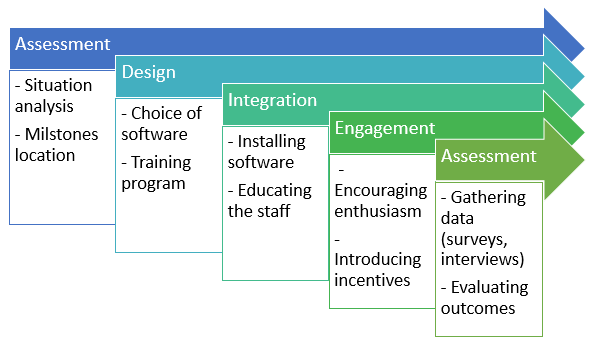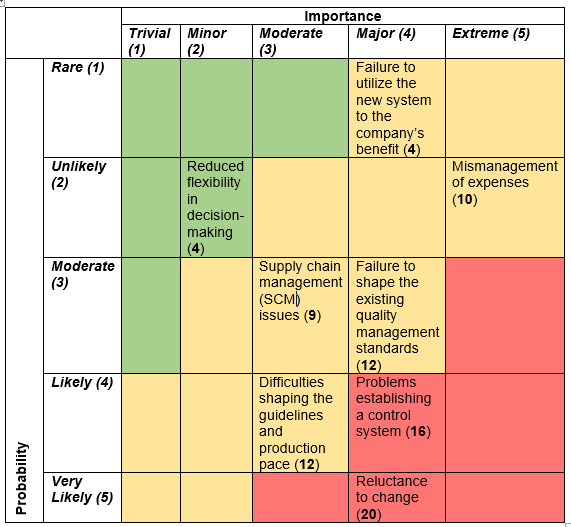Introduction – Executive Summary
Innovative technology allows moving a company forward by establishing new options for communication with its stakeholders and increasing the quality of its services and products. However, the described change also suggests facing several challenges associated with resistance to change among employees and teaching them to use new equipment (Adeleke, Lawal, Adio, & Adebisi, 2015). In the case under analysis, the integration of task management software into the workplace processes is expected to minimize time spent on managing responsibilities, as well as prioritize assignments among staff members.
Combined with the assistance of a Health Information Professional (HIP), the strategies geared toward staff education and increase in the level of their proficiency are expected to produce a tangible impact on the current levels of data management quality and efficacy of implementing critical project goals. Therefore, the introduction of the strategies aimed at increasing the current employee engagement rates, reducing the levels of fear and reluctance toward changes among them, and building an HPW-based project management system are the primary objectives.
Purpose of Project Management Plan
The purpose of the project management plan is to introduce the framework for integrating task management software into the setting of the selected organization. In the process, staff members should be prepared and willing to use innovative task management tools in order to prioritize their workplace responsibilities and transfer data within an interdisciplinary environment effectively. The project management plan will establish a clear framework for
Project Charter
The purpose of the project charter is to outline the roles and responsibilities of each participant and outline the tasks to be accomplished, as well as the criteria based on which the extent of the project implementation success will be measured. In addition, the key stakeholders will be outlined in the process. As the project charter below indicates, the stakeholders are represented by the team of nurses, patients to whose needs the nurses will cater, the vendor, investors, the healthcare organization, in general, and the local community on the whole when considering the public health scope.
Figure 1. Project Charter for Introducing Task Management Software.
As the charter provided above shows, the project is expected to be implemented with the support of an HIP expert. The issue of communication and negotiation with staff members requires further elaboration, as well as the role of incentives in boosting employee engagement rates. Additionally, the problem of employee engagement along with the notions of employee motivation and employer engagement will be scrutinized to structure an optimum framework for meeting the stakeholders’ needs.
Project Scope
The current project scope embraces the needs of patients in the facility and, on a broader scale, the local community. The needs of a larger community may need to be taken into consideration in further projects. Thus, the project will gradually expand to focus on global issues.
Procurement Plan
Cost Estimate
Figure 2. Cost Estimate.
The current analysis of risks and expenses associated with the introduction of task management software shows that the salary offered to the HIP expert, the purchase of the tools form vendors, and the provision of incentives to team members will take the greatest a number of investments. The total costs of the project can be reduced by reconsidering the options for the task management software and the range of skills that the staff will acquire with the help of the HIP. Nevertheless, the current range of expenses should be seen as the most probable one.
Procurement Plan

As the plan for procurement shows, it is critical to lay the foundation for the introduction of task management software into the designated setting. The process of increasing awareness of the necessity to change will also take a certain amount of time (Hovenga & Grain, 2016). The education process along with the management of critical data by an HIP will constitute the greatest amount of time, whereas the assessment of results and the location of future goals will be carried out at the end of the project implementation.
Baseline Management and Staffing Plan
The current base line management plan includes the following steps:

The rationale behind choosing the specified quality criteria concerns the necessity to introduce team members to the idea of continuous learning and independent development of critical competencies for managing the software. In addition, the importance of interdisciplinary collaboration should remain prominently high.
[Insert the project’s Responsibility Assignment Matrix (RAM), and base line management plan that describes the rationale behind your RAM.]
Risk Assessment and Quality Plan
The process of managing risks will require introducing incentives for staff members to maintain engagement and enthusiasm. One should also mention the challenges associated with the rearrangement of the current standards of quality and principles of assigning roles and responsibilities to staff members (see Fig. 2). Nevertheless, the application of the communication practice that involves openness and employee engagement will help to overcome the described issues.

According to the project’s Risk Matrix, the issues associated with the transfer to the new framework of managing patient data is expected to pose the greatest threat to the viability of the entire project. Therefore, the current quality plan has to be updated to contain very clear criteria for high-quality performance in the target setting.
Project Communication Plan
Stakeholders and Documentation
Currently, it is critical to ensure that employees are fully aware of the changes that are going to take place in the management of data, as well as the importance and legitimacy of these changes. The role that education about the use of software and the understanding of its functions is another priority that the project in question targets to attain. Therefore, staff members are seen as the key stakeholders (Hornstein, 2015).
They include nurses, physicians, and other healthcare department members. Each of the stakeholders will receive documentation detailing their roles and responsibilities in managing the schedule and data with the help of the new software. In addition, concise yet accurate and clear guidelines will be included in the documentation to ensure that employees manage the software properly. Finally, information about the training sessions will be offered to employees to ensure that they receive proper guidance and support from an HIP.
Project Communications Plan
- Project Title: (Add the title here.)
- Project Sponsor: (Add the sponsor’s title or role here.)
- Project Manager: (Add your name here as the project manager.)
(List all project communication types in Table 1. Provide the applicable information in each column for each communication type listed. Add rows to the table, as needed.)
Table 1: Project Communications.
Stakeholder Communications
Introducing employees to the goals and development of the project allows addressing two major concerns simultaneously. Being aware of the objectives and progress of the process, the participants will be less afraid of negative outcomes and, thus, less reluctant to participate in it. Moreover, with a clear layout of the stages of education an integration of the time management software, the staff members will be able to control their professional development and figure out the pace at which they will absorb new knowledge most effectively. Herein the significance of communicating project data and information lies.
For this purpose, strategies such as the use of active listening will be used due to the opportunity to engage staff members in a discussion (Butt, Naaranoja, & Savolainen, 2016). As a result, employees are expected to build a substantial amount of prowess in managing the time management software to increase their productivity and prioritize key tasks.
Tools for Communicating the Progress to Stakeholders
The choice of the approaches toward communication between the team leader and the participants will have a profound effect on the success of implementing the proposed change, specifically, educating staff members, avoiding the associated risks, and reducing the threat of high reluctance levels in the target audience. For the project to be implemented fast and have a lasting impact, a combination of traditional and digital communication tools should be deployed.
Using openness in a direct dialogue with team participants will help to establish the atmosphere of trust, whereas the application of digital conferencing tools will help to time conversations to meet the needs of all participants. In addition, the application of digital conferencing tools may spur the process of knowledge sharing among participants, which will establish a more comfortable atmosphere and be conductive to staff members’ accepting the new innovation-driven corporate philosophy.
References
Adeleke, I. T., Lawal, A. H., Adio, R. A., & Adebisi, A. A. (2015). Information technology skills and training needs of health information management professionals in Nigeria: A nationwide study. Health Information Management Journal, 44(1), 30-38. Web.
Butt, A., Naaranoja, M., & Savolainen, J. (2016). Project change stakeholder communication. International Journal of Project Management, 34(8), 1579-1595. Web.
Hornstein, H. A. (2015). The integration of project management and organizational change management is now a necessity. International Journal of Project Management, 33(2), 291-298. Web.
Hovenga, E., & Grain, H. (2016). Learning, training and teaching of health Informatics and its evidence for informaticians and clinical practice. Evidence-Based Health Informatics, 222, 336-354. Web.